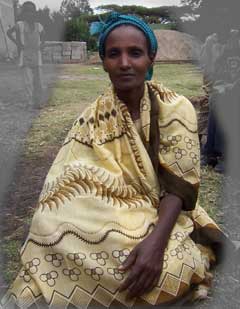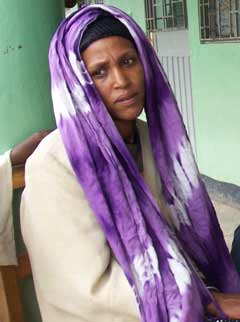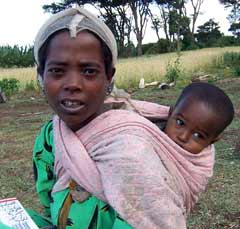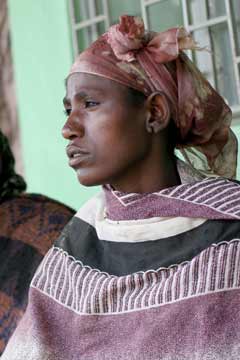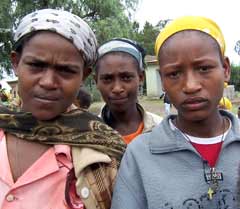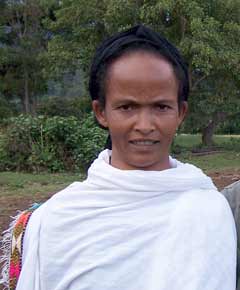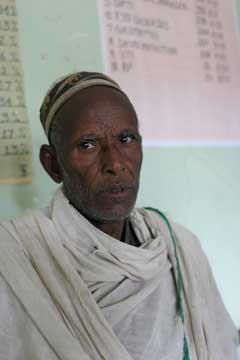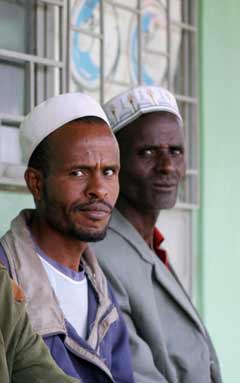Ethiopia
2006
~
Life Stories

What a privilege to have heard the stories of so many! This was no ordinary vacation to Ethiopia! Here we were, westerners welcomed into the private lives of many, each one with their own tale of pain and triumph. Each one showed a slice of our own human story; each one baring, momentarily, in trust, his heart, and in so doing acting as a mirror for my own heart. I give my thanks and gratitude for being privileged to listen. My prayer is that in so doing I lightened the burden for some.
A woman visited the clinic because of abnormal bleeding. This had troubled her for many months and was beginning to interfere with her energy level. As bleeding continues over time, the energy drain on the body becomes gradually more significant. As was true for many women, the work load for her was great and she was expected to contribute her share to the family. There were six children and a husband in addition to her, all requiring food and care. She and her husband, like many in the area, were “farmers.” This meant, generally, that they worked the land that they leased, living on the produce and raising cattle, sheep, and chickens but not being otherwise gainfully employed. In their particular case, unlike many others, they also produced a “cash” crop – onions – that they sold at market in order to create a little cash to be used for other essentials. They earned 300 birr yearly from the onion crop. This is about 35 US$ and is far below the Ethiopian average of 1200 birr. We were delighted to be able to help her with her bleeding problem. We gave her medication that should help in the short run and offered advice for how to deal with this in the long run.
Another woman came in because of pain and discharge. She was about 30 years old. Her husband had died a year earlier because of “an illness” (unspecified). We helped her medical issues and also learned that she was one of a handful of people we would see that day that were not farmers: She was a merchant. She bought and sold teff, the wheat like grain that was used to make injera, the flat bread unique to Ethiopia. As a teff merchant she bought the crop from the local growers and took it to regional markets where it was sold to others. Her business yielded about 1800 birr yearly, enough for her and her family of five children to live in that village. One wondered, “What happens in times of drought?” These small family farms would fail and all the others dependent upon them would also fail.
Another woman’s husband had also died a year earlier, also due to “an illness.” It seems there were many unspecified illnesses. This woman’s plight was quite different, however. Also about 30 years old, she had had six pregnancies and six cesarean sections, each of which had delivered an already deceased baby after long arduous labors. Now she had a fistula between the bladder and the vagina. Urine poured out during the examination – I wondered if it is ok for the doctor to weep during an exam – just as it did throughout the day, uncontrollably, anywhere she was. She was an outcast, put out by her family and society. She needed surgery and we encouraged her to seek care at the government hospital where the care would be free. But first she needed to get there…
Another woman came in, this one with childbirth trauma of a different kind. She also had had six babies, all living in this case, with no cesareans. Her pelvic supporting structures, though, had been damaged by the pregnancies and deliveries, and she had been left with complete prolapse of her uterus and vagina. It had “fallen” completely outside of her body, hanging as a constant reminder of her “fallen” state as a wife: Her husband had divorced her, taking up with a younger woman who was still intact, for the complete prolapse had left my patient as an unsuitable partner for marital relations. Once again, the ravages of this hard life had left this one destitute, along with her children, cast off due to the lack of care, both medically and familial. Once again, the societal treatment of women showed its shame: cast aside, like chattel, devalued at the whim of the husband.
Another woman, limping from a lame right leg, came in also because of childbirth trauma. A few years earlier she had had an obstructed, long labor – why don’t they caution girls about the dangers? – and had suffered greatly as a result. The long pressure against her pelvic structures had not only caused the death of the baby involved but also had led to pressure necrosis (death) of several tissues in her pelvis – the wall of the bladder, the wall of the rectum, and a nerve that coursed along the right pelvic side wall. Hence the lame right leg – the nerve damage – but also a constant leakage of urine and feces through the vagina was present. This unfortunate woman needs surgery to correct the leakage – and we offered helpful information about how she could secure that treatment – but for the nerve damage there is nothing. She will forever walk with a limp, a sad testimony to a preventable, yet untreatable, problem.
Yet another woman came due to fistula. This one, young and with baby in tow, also told her sad tale of birth injury. Again, her story had its beginning with a long, obstructed labor. She however had been fortunate enough to have the fistulae – both bladder and rectum – repaired in Addis. Her good fortunes ran out though when the bladder fistula returned. There was a wound problem and the opening reappeared. Her exam revealed much: Urine poured out, puddling on the exam table, running onto the floor. Shame covered her eyes and filled her face, the same shame that husbands, families, society heap on these unfortunates. Meskerem (my translator) and I exchanged disquieted glances. I wanted so desperately to offer more…
A man came in (yes, I did see a few men!) with weight loss and non-productive cough. He was 40 to 50 years old. He had sunken eyes and an embarrassed yet kindly smile. He told his story of a long progressive illness, bouts of feeling better or worse along the way. He was getting along ok but wondered, and was worried about, the recent change in weight and cough. We pointed him toward the tests that would help sort out his concerns – he needed a chest xray and an hiv test – but also offered some temporary comfort care with some of the medications and vitamins we had brought along for just this type of situation.
A thirteen year old boy presented with lumps behind the long neck muscle on his left side (the sternocleidomastoid muscle). He had had these before and they had been removed surgically. He had been told they were from tuberculosis back then about a year ago. Now he also had a cough and fever. He looked strong and big for his age and when he had first come in we laughed together as I had tried to introduce myself in Amharic. Meski had bailed me out (again). Now, though, after telling his story and hearing that he needed a chest xray, he seemed weaker and afraid. His telling and my recommendation had taken something from him. I asked what was happening. He said he lived with his sister, that his parents were far away and “were sick,” and that it was impossible to get an xray. Meski offered that the parents probably had hiv, a thought that had not occurred to me but which made sense. I asked if his sister was here with him and we brought her into the room. I asked her, 18 years old, if she could get him to a hospital where he could get an xray. She not only said yes, she said, “Of course.” His countenance brightened. Neither mine nor Meski’s did, at least on the inside – the realization that he probably had tuberculosis in combination with hiv was too real.

